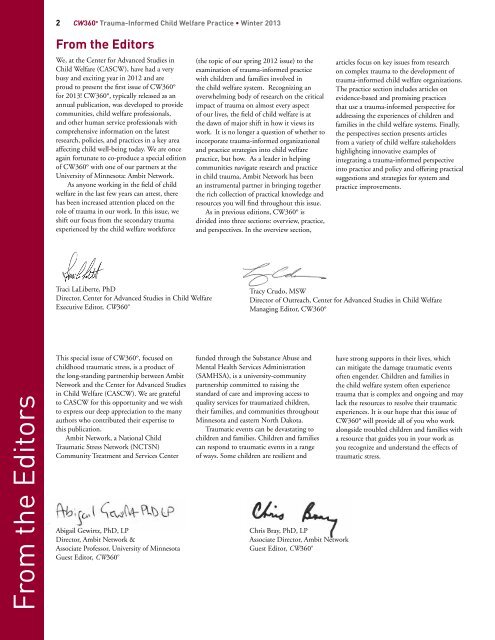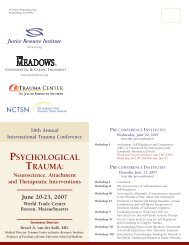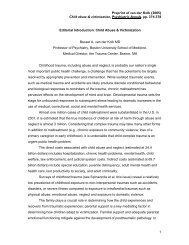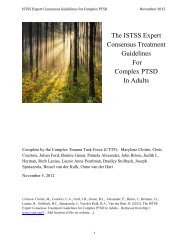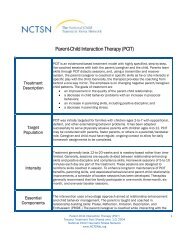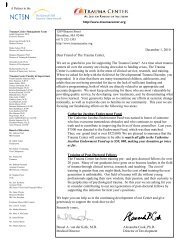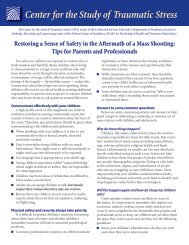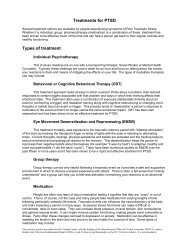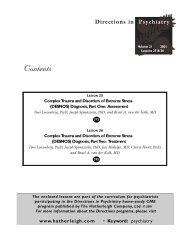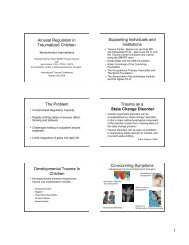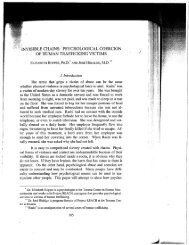in Child Welfare - The Trauma Center
in Child Welfare - The Trauma Center
in Child Welfare - The Trauma Center
You also want an ePaper? Increase the reach of your titles
YUMPU automatically turns print PDFs into web optimized ePapers that Google loves.
2 CW360 o <strong>Trauma</strong>-Informed <strong>Child</strong> <strong>Welfare</strong> Practice • W<strong>in</strong>ter 2013From the EditorsWe, at the <strong>Center</strong> for Advanced Studies <strong>in</strong><strong>Child</strong> <strong>Welfare</strong> (CASCW), have had a verybusy and excit<strong>in</strong>g year <strong>in</strong> 2012 and areproud to present the first issue of CW360°for 2013! CW360°, typically released as anannual publication, was developed to providecommunities, child welfare professionals,and other human service professionals withcomprehensive <strong>in</strong>formation on the latestresearch, policies, and practices <strong>in</strong> a key areaaffect<strong>in</strong>g child well-be<strong>in</strong>g today. We are onceaga<strong>in</strong> fortunate to co-produce a special editionof CW360° with one of our partners at theUniversity of M<strong>in</strong>nesota: Ambit Network.As anyone work<strong>in</strong>g <strong>in</strong> the field of childwelfare <strong>in</strong> the last few years can attest, therehas been <strong>in</strong>creased attention placed on therole of trauma <strong>in</strong> our work. In this issue, weshift our focus from the secondary traumaexperienced by the child welfare workforce(the topic of our spr<strong>in</strong>g 2012 issue) to theexam<strong>in</strong>ation of trauma-<strong>in</strong>formed practicewith children and families <strong>in</strong>volved <strong>in</strong>the child welfare system. Recogniz<strong>in</strong>g anoverwhelm<strong>in</strong>g body of research on the criticalimpact of trauma on almost every aspectof our lives, the field of child welfare is atthe dawn of major shift <strong>in</strong> how it views itswork. It is no longer a question of whether to<strong>in</strong>corporate trauma-<strong>in</strong>formed organizationaland practice strategies <strong>in</strong>to child welfarepractice, but how. As a leader <strong>in</strong> help<strong>in</strong>gcommunities navigate research and practice<strong>in</strong> child trauma, Ambit Network has beenan <strong>in</strong>strumental partner <strong>in</strong> br<strong>in</strong>g<strong>in</strong>g togetherthe rich collection of practical knowledge andresources you will f<strong>in</strong>d throughout this issue.As <strong>in</strong> previous editions, CW360° isdivided <strong>in</strong>to three sections: overview, practice,and perspectives. In the overview section,articles focus on key issues from researchon complex trauma to the development oftrauma-<strong>in</strong>formed child welfare organizations.<strong>The</strong> practice section <strong>in</strong>cludes articles onevidence-based and promis<strong>in</strong>g practicesthat use a trauma-<strong>in</strong>formed perspective foraddress<strong>in</strong>g the experiences of children andfamilies <strong>in</strong> the child welfare systems. F<strong>in</strong>ally,the perspectives section presents articlesfrom a variety of child welfare stakeholdershighlight<strong>in</strong>g <strong>in</strong>novative examples of<strong>in</strong>tegrat<strong>in</strong>g a trauma-<strong>in</strong>formed perspective<strong>in</strong>to practice and policy and offer<strong>in</strong>g practicalsuggestions and strategies for system andpractice improvements.Traci LaLiberte, PhDDirector, <strong>Center</strong> for Advanced Studies <strong>in</strong> <strong>Child</strong> <strong>Welfare</strong>Executive Editor, CW360 oTracy Crudo, MSWDirector of Outreach, <strong>Center</strong> for Advanced Studies <strong>in</strong> <strong>Child</strong> <strong>Welfare</strong>Manag<strong>in</strong>g Editor, CW360°From the EditorsThis special issue of CW360°, focused onchildhood traumatic stress, is a product ofthe long-stand<strong>in</strong>g partnership between AmbitNetwork and the <strong>Center</strong> for Advanced Studies<strong>in</strong> <strong>Child</strong> <strong>Welfare</strong> (CASCW). We are gratefulto CASCW for this opportunity and we wishto express our deep appreciation to the manyauthors who contributed their expertise tothis publication.Ambit Network, a National <strong>Child</strong><strong>Trauma</strong>tic Stress Network (NCTSN)Community Treatment and Services <strong>Center</strong>Abigail Gewirtz, PhD, LPDirector, Ambit Network &Associate Professor, University of M<strong>in</strong>nesotaGuest Editor, CW360 ofunded through the Substance Abuse andMental Health Services Adm<strong>in</strong>istration(SAMHSA), is a university-communitypartnership committed to rais<strong>in</strong>g thestandard of care and improv<strong>in</strong>g access toquality services for traumatized children,their families, and communities throughoutM<strong>in</strong>nesota and eastern North Dakota.<strong>Trauma</strong>tic events can be devastat<strong>in</strong>g tochildren and families. <strong>Child</strong>ren and familiescan respond to traumatic events <strong>in</strong> a rangeof ways. Some children are resilient andChris Bray, PhD, LPAssociate Director, Ambit NetworkGuest Editor, CW360 ohave strong supports <strong>in</strong> their lives, whichcan mitigate the damage traumatic eventsoften engender. <strong>Child</strong>ren and families <strong>in</strong>the child welfare system often experiencetrauma that is complex and ongo<strong>in</strong>g and maylack the resources to resolve their traumaticexperiences. It is our hope that this issue ofCW360° will provide all of you who workalongside troubled children and families witha resource that guides you <strong>in</strong> your work asyou recognize and understand the effects oftraumatic stress.


